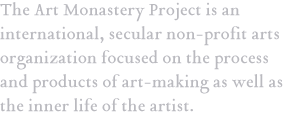The Ages of Western Monasticism
From P. Langdale Hough at Plumblines:
From Walled Towns (1919), by Ralph Adams Cram (courtesy of Schmitz). Pages 34 – 35:
At the beginning of the Christian the impulse was personal, the individual was the unit, and the result was the anchorites and hermits, each isolating himself a hidden mountain cave, a hut in the desert, or if his fancy took this eccentric, on the top of a lonely column, like St. Simon Stylites. With St. Benedict the group became the unit, a sort of artificial family either of men or of women, as the case might be. He himself began as a hermit in the cleft of a far mountain, but within his own lifetime his original impulse was overridden and the new communal or group life came into being, though each monastery or convent was quite autonomous and self-contained. Five centuries later (or four to speak more exactly) began the Cluniac reform, which was followed by the Cistercian movement, and here, though the old Benedictine mode was followed at first, in a brief time came the differentiation, for now all the houses of one order were united under a centralizing and coordinating force. Here we have the State as the parallel of the new scheme. Latest of all, in other five centuries, came still a new model, the army, with the Society of Jesus as its perfect exponent. So we have at almost exact five century intervals four models of monasticism: the individual, the family, the State, and the army. A fifth is now due; what will be its form?
Hough responds:
How does Cram’s historiographical theory make sense of the small monastic communities found in the letters of St. Jerome? Or of the eremitical revival which accompanied the rise of Cluny in the 11th century? Or the conflict between Cluniacs and the Cistercians and their disagreements regarding centralized governance? Or the representative democracy of the Dominican constitution of the 13th century that was deeply grounded in familial relationships? Or the rise of the Military Orders during the era of “State” monastic scheme? Or how the Jesuits and the Carmelites could share a common spirituality yet pursue very different forms of religious life? While Cram’s thesis is an interesting one, any further reflection on the development of monastic life in the West necessarily requires one to reject it.
Hough’s informed response takes some of the juice out of Cram’s monastic teleology, but a new kind of monasticism nevertheless seems to have been cooking for the past fifty or so years. In keeping with Cram’s “the individual, the family, the State, and the army,” to what shall we compare it?
The marketplace? The network? The city? The farm? The artist colony?From P. Langdale Hough at Plumblines:
From Walled Towns (1919), by Ralph Adams Cram (courtesy of Schmitz). Pages 34 – 35:
At the beginning of the Christian the impulse was personal, the individual was the unit, and the result was the anchorites and hermits, each isolating himself a hidden mountain cave, a hut in the desert, or if his fancy took this eccentric, on the top of a lonely column, like St. Simon Stylites. With St. Benedict the group became the unit, a sort of artificial family either of men or of women, as the case might be. He himself began as a hermit in the cleft of a far mountain, but within his own lifetime his original impulse was overridden and the new communal or group life came into being, though each monastery or convent was quite autonomous and self-contained. Five centuries later (or four to speak more exactly) began the Cluniac reform, which was followed by the Cistercian movement, and here, though the old Benedictine mode was followed at first, in a brief time came the differentiation, for now all the houses of one order were united under a centralizing and coordinating force. Here we have the State as the parallel of the new scheme. Latest of all, in other five centuries, came still a new model, the army, with the Society of Jesus as its perfect exponent. So we have at almost exact five century intervals four models of monasticism: the individual, the family, the State, and the army. A fifth is now due; what will be its form?
Hough responds:
How does Cram’s historiographical theory make sense of the small monastic communities found in the letters of St. Jerome? Or of the eremitical revival which accompanied the rise of Cluny in the 11th century? Or the conflict between Cluniacs and the Cistercians and their disagreements regarding centralized governance? Or the representative democracy of the Dominican constitution of the 13th century that was deeply grounded in familial relationships? Or the rise of the Military Orders during the era of “State” monastic scheme? Or how the Jesuits and the Carmelites could share a common spirituality yet pursue very different forms of religious life? While Cram’s thesis is an interesting one, any further reflection on the development of monastic life in the West necessarily requires one to reject it.
Hough’s informed response takes some of the juice out of Cram’s monastic teleology, but a new kind of monasticism nevertheless seems to have been cooking for the past fifty or so years. In keeping with Cram’s “the individual, the family, the State, and the army,” to what shall we compare it?
The marketplace? The network? The city? The farm? The artist colony?
Leave a Reply
You must be logged in to post a comment.




